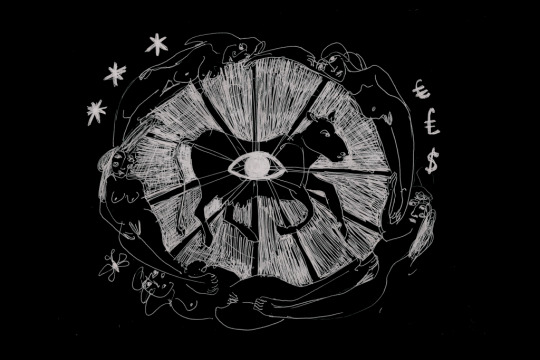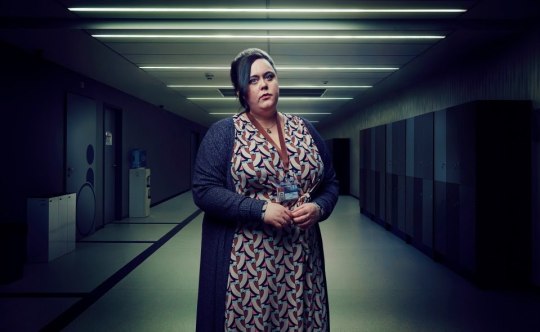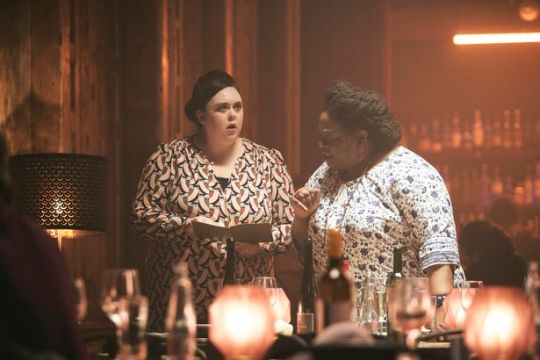#nina royle
Explore tagged Tumblr posts
Text

gloves by nina royle, 2021, ink & oil on a shaped wood & gesso panel, 40 × 36 centimeters
76 notes
·
View notes
Photo


(via Global Cows 2020 | Conceptual Fine Arts)
A collaboration with Brussels-based gallery Damien & The Love Guru, our new online exhibition presents a double digital interactive fresco companion to the fresco secco painted one year ago in Brussels by Vanessa Disler, Tiziana La Melia, Nina Royle, Lucy Stein and Charlott Weise. The show is accompanied by a new text by Sonia D’Alto. Follow the link for exploring the project.
#online exhibition#digital art#painting#cow#drawing#lucy stein#vanessa disler#tiziana la melia#nina royle#charlott weise#female art#women artists
3 notes
·
View notes
Text
'LOVE-HATE: The Teacher stars Sharon Rooney and Sheridan Smith felt so bad filming mean scenes they’d apologise after
(Scottish Sun, 31 January 2022)
DISNEY actress Sharon Rooney has hailed her on-screen rival Sheridan Smith for taking on the role of a teacher accused of sleeping with a young pupil.

The taboo Channel 5 drama, called Teacher, sees a popular educator plead guilty to the sexual offence and lose her job.
[[MORE]]
But all sorts of twists and turns later emerge, casting doubt over what really happened on the night in question.
Sharon, who plays know-it-all English teacher Nina, admits she was seriously impressed by Sheridan, 40, in her controversial portrayal of Jenna Garvey.
The Glasgow-born actress, 33, who portrayed Miss Atlantis in the big-budget 2019 flick Dumbo, says: “Sheridan and I had said hello to each other previously, but never worked together and I was so thrilled to be on set with her.
“She was on my bucket list of actresses to work with, which keeps getting smaller as I get more opportunities.
“It’s quite funny though, because I spent the whole time glaring at her in every scene, but then the minute they shouted ‘Cut’ we were laughing together.
“Having Sheridan in the lead is just genius, she’s so great.”
Lead star Sheridan, famous for roles in The Royle Family and Two Pints of Lager and a Packet of Crisps, also enjoyed her on-screen spats with Sharon.
She adds: “Sharon is the loveliest girl, but our characters are so horrible to each other – we’d do our scenes and then apologise and hug afterwards.
“I’ve always been a fan of hers, she’s great and not like her character, Nina at all.”
Sharon, who shot to fame on teen comedy drama My Mad Fat Diary, reckons the programme will get people talking.
After being formally charged with having sex with a minor, the press get hold of her story and let rip with salacious stories, Jenna has to move in with her father and loses all of her friends.
MORE THAN MEETS THE EYE
But it’s hinted that there’s more than meets the eye with the scandal.
Sharon says: “It’s so clever, it sucks you in and you keep changing your mind about what’s happened.
“That’s what great telly is, and I hope people will grab a cup of tea and a blanket, and buckle in.
“I don’t know if I would have the willpower to watch one episode at a time with this show, it’s definitely worth a binge watch – it’s the kind of show where you say, “I’m going in, no-one talk to me, I’m muting my phone and I’ll be back when it’s done!”

The actress, who also starred in the pilot of hit comedy Two Doors Down, is used to playing younger characters.
So she admits it was a surprise when she found out she was going to be both a mum and teacher in her latest job.
However she enjoyed the change of pace and reckons it made her view school in an entirely different light.
Sharon explains: “Nina is quite a character – she takes no prisoners and she says exactly how she feels.
“She reminds me of those ex-smokers who are the worst when it comes to telling people to stop smoking.
“She hasn’t got a chip on her shoulder, she's got a bag of chips on her shoulder.
'TAKES NO PRISONERS'
“Nina isn’t perfect in any way, she has a past, but she can’t see that anymore because she tries so hard to be the opposite of what she used to be.
“Nina has become this reformed teacher, a grown-up, and she’s forgotten where she came from.
“That's what bugs her so much about Jenna – she can't understand why she's not behaving like an adult.”
She adds: “I was so chuffed to get the job because it really is something quite different for me."
“I look like an adult in the show too, which is so funny to me, because I'm so used to playing the young ones.
“When I heard about the job, I thought my agent was putting me forward for one of the kids – I’m not used to playing the mum with the chip on her shoulder – I'm used to playing the teenager who caused the chip.
NEW ENVIRONMENT
“I’m quite shy in real life as well, so it’s fun to play someone so bossy and cheeky. I was always the one messing about at school, being silly.
“So, from the minute I stepped into that environment for filming, a little part of me still wanted to joke about and make people laugh.
“It was very weird being in the staff room – I've never been in one before but I was always that kid at the door trying to peek in to see what they do in there.
“But actually I’ve discovered it's just a lot of marking, chatting and drinking coffee, there are no secrets.
“I had to really remind myself I was the teacher, not one of the kids.
“I am used to playing the one without a care in the world rather than the grown-up telling the kids to put their ties on and get to class, it was really strange.”
UNCOMFORTABLE VIEWING
Sheridan also hopes that folk see the serious side of the situation and question every twist and turn.
The actress researched some similar real-life cases to try to understand their mentality.
And she reckons her chaotic character could split opinion among viewers.
She says: “There are teacher-student boundaries and she has maybe let that slip.
“And then of course her life outside of the classroom is chaotic.
“I really hope people don't know what to think about her.
“There were scenes where I was thinking, ‘This is so terrible, you'd be fired immediately,’, her actions didn't sit right with me, but I enjoyed playing them as well.
“It will make incredibly uncomfortable viewing and you won’t know if you like her or not.”
But as long as the audience like the show then she’ll be happy.
Sheridan adds: “Hopefully there will be lots of people not knowing if they trust me as Jenna – there are bits where it looks like I could be quite sinister.
“I hope there are a lot of conversations about whether she is guilty, especially as all the twists and turns come out, it gets so complicated and dark.
"Just can't wait for the audience to see it – when I first read it I was gripped and I hope they feel the same and come on the journey with us.”
The Teacher will launch on Monday, January 31 at 9pm on Channel 5.' X

#sharon rooney#sheridan smith#the teacher#channel 5#interview#2022#february 2022#drama#tw teacher/student
7 notes
·
View notes
Link
Death in Paradise may have a rather sinister name (and plotline!), but its white sandy beaches and hot sunshine look pretty idyllic if you ask us. Take away Detective Inspector Neville Parker, played by Ralf Little, investigating murder cases and you've got yourself an unspoilt and relaxing holiday! It is filmed on the stunning French Caribbean island of Guadeloupe, and HELLO! caught up with the creators of the series to understand the reason they chose the gorgeous destination.
According to Executive Producer Tim Key, who works alongside Ella Kelly, there were two main reasons they opted for the Caribbean, both of which were very practical. "There's the way it looks - especially the side of the island that we're on. It looks beautiful but also it's not overdeveloped, it's not a very modern Caribbean island, nor is it less developed - it's just right for us," he said. "It is it's own little place because one side is very flat and more developed and we're on the less flat, harder to get around side, but it's a stunning place."
He continued by explaining there is a mutual financial and economic benefit between the BBC series and the country. "Secondly, because it's a French department so the currency is the Euro and we qualify for the tax rebate so we can afford to shoot the show here basically," said Tim. "On top of that, the Guadaloupe regional council has always been very very keen to have us there so there's an organisation that promotes filming there and they've always been very helpful as well."
While he spoke highly of the location, describing it as a "wonderful, beautiful place," some of the cast have revealed it is not as perfect as it appears. Discussing the worst thing about filming in the Caribbean, Nina Wadia said: "Scolopendras are these really hideous insects" which she described as "a centipede with scorpion bits." Shyko Amos also voiced her dislike for the bugs, stating: "And they bite you, and they sting, and to kill them you need to use a hammer."
However, 39-year-old Ralf, who is best known for his roles in hit-sitcoms The Royle Family and Two Pints of Lager and a Packet of Crisps, still seems excited to spend time on the island. Speaking of his new role, said: "It took less than 0.005 seconds to say yes to playing the new DI! How could I not? Ardal has been wonderful in the last few series and to follow in his footsteps in a place as idyllic as Guadeloupe was a great honour and a dream come true. It is a joy to play Neville and I can’t wait for viewers to see him in Paradise this series."
14 notes
·
View notes
Photo

#NewArtShow 10-11-22 - Arusha Gallery - Nina Royle - Down Your Tresses ARUSHA GALLERY 13A Dundas Street, Edinburgh EH3 6QG Nina Royle: Down Your Tresses. Nov 11-Dec 4. Mon-Sat 10-5, Sun 1-5 t 0131 557 1412 e-m [email protected]  arushagallery  @arushagallery  arushagallery web www.arushagallery.com https://www.instagram.com/p/CkxcSj1ITUV/?igshid=NGJjMDIxMWI=
0 notes
Link
The Sunset and the Dream
At sunset, under an oak tree, five women danced in a circle. During the pilgrimage, they encountered Pan, a Greek deity playing the flute. They had brushes and colors at their feet. Sheets of poetry were scattered in the grass. The landscape was bucolic, and they shared their time with the herds of cattle, brambles and weathered scarecrows. It seemed like a dream, or an echo that let a vision perforate. Maybe it was a spiritual union, a dialectical re-enchantment of humans and nature, a negotiation with the invisible in time and space, without contact. Linear time no longer worked, crumbling at the circular dance of the five women. As for space, there were no more borders. Everything was projected into the vision, which turned into a screen where the tears of monarch butterflies joined hypertext links. The revelation—worthy of a historical catastrophe—announced the hope of salvation. Gradually, the dream became less evanescent, revealing the identity of the five women: Vanessa Disler, Tiziana La Melia, Nina Royle, Lucy Stein and Charlott Weise. Together, they worked on a large fresco-secco painting, where they told ancient and remote stories of a pagan past, of mythical forms reverberating globally with divergent meanings.
The Night and the Invisible
Hecate, the great goddess of circular time and spirits initiated the artists into the invisible realm of the night. Ancient knowledge poured forth, suggesting new alliances. ‘Change the world as soon as possible, before the animals also perish’, Hecate suggested. The archaic lives in the present-day. Let’s forget the idea of progress as a way to make space for new stories and new crops. Imagine forgetting consumerist myths. The hedonism of personal and individual worship had to be abandoned for a “culture of difference.” Hecate protected the artists with a spell of invisibility and concealment, at the limits of anonymity, focusing on the impersonal gesture of gentlehands, and the sharing of artistic property in order to claim another form of identity. It was about transgressing the dogma of the separate individual for an act of kinship and sympoiesis, reactivating awareness of interdependence to nourish the planet. A secret alliance with planetary solidarity was made palpable on the screen, in the collective drawing. Only in this way could the miracle be accomplished. Only in the power of an invisible self could it be realized. The real trick was to disappear.
The Day and the Parasite
Carrying on with a sense of mutual belonging, this bizarre council of artists decided to use their shared resources in solidarity with the planet. The circle dance was based on the cycle of nature and solidarity between species. A spell was cast with a wand: the shared brush.. An interactive energy circulated through the constellations of the night sky, and then the daytime sky. A warm, maternal sun distilled rays and fertilized the language of the artists. The fresco-secco was mixed with new sketches obtained from the stroke of a ballpoint pen, and arranged interactively upon a screen. A collective body, nourished by affective substance, of intrusions and expulsions, blessed in collaboration with an awareness of interdependence, turned to absolute freedom of coexistence and reversibility. Sharing the creative gift was an act of hospitality. The cycles and structures of the artists’ work multiplied. They were engulfed in autopoietic virtual parasitisms. A symbiosis between formal elements, intertextual connections and intersubjective relationships. Each leeched off the other, burgeoning life. In a chain of parasites, one body is a host of another. In this story, the parasite was a large sprawling and neoliberal beast. It had to be inhabited from within, in order to grasp its own tentacles. “[…] we go directly into the belly of a parasite. Think of its stomach, where the natural animal kingdom has found its battlefield of union, the crucible of closest fusion, the organ connecting the various animal species.” (Marx in Timofeeva 2016)
The Eclipse and the Boundaries
Concealment happened astrally, with an eclipse that lined up three celestial bodies. The phenomenon of the eclipse distilled moon droplets and solar rays on Earth. It spread along on the ground as an anomalous flora, called broom, a flower that had inspired poets and ancient legends. It was said that its ashes contained gold. Nature continued to produce great things by following and feeding its cosmic course, but also by constantly destroying those things too. In the meantime, humans began to harness nature ever more treacherously, both in the process of creation and destruction; believing in an illusion of cultivation, they forgot the miracle of broom. With indifference, the miracle of broom entered the undergrowth, waiting to be recognised again. Herds of animals moved freely among its branches and flowers. Those yellow flowers were the only borders. Everything flowed in a mysterious and autonomous way, with a sympathetic reaction. There was more than mere life in the ruins and the fragility of the living. “While the miracle repeats, and nature keeps replying to its sly parasite with a silent yes,”(Timofeeva 2016) the artists continued to dance and work on this drawing of solidarity and collaboration between the species.
The Cosmos under the New Moon in Taurus
A pilgrimage of global hope began to dissolve into a planetary need. This cosmic vision emanated a sense of swallowing and regeneration, a sprout for new relationships between the species and a pacified syncretism. There was a complex, multiplied image made up of several layers on the screen. It looked like a palimpsest, in which pre-existing images resisted the intrusion of new ones, like snapshots of memories, and of dreamlike fragments. The almond shape from the legend of the vescica piscis; an ancient symbol in Indian and Mesopotamian culture, later appropriated by Christianity, alluded to a grain. It alluded to a planetary membrane joined in the complexity of our lives: the inside with the outside, the real with the virtual, the day with the night, the human with the natural. It emitted a cosmic and rhizomatic dust, embracing and interlacing human and non-human relationships and anatomies. Similarly, in a non-dogmatic and free-spirited way, the accumulation of the artists energies and work compiled into a layered vision of drawings, small icons, audio tracks, and constellations of notes, which made up a virtual and subtle fresco. Under the cast of the new moon in taurus, their drawing communed with the cosmos and the tears of the monarch butterfly connected the planetary dreams of the artists to the allied eyes of the curious visitor. Even their dreams, in the nights to come, would be that of “a child born for sympoiesis—for becoming-with and making-with a motley clutch of earth others.” (Haraway 2016, p. 137)
https://www.conceptualfinearts.com/cfa/2020/05/05/global-cows-2020/
0 notes
